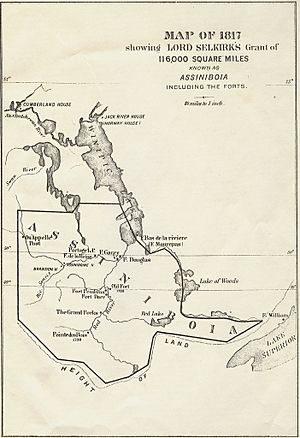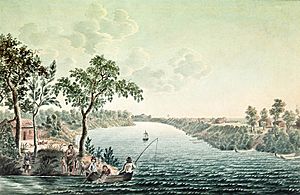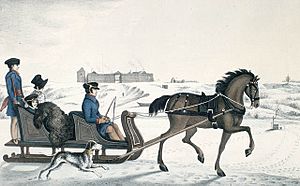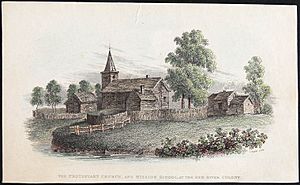Red River Colony facts for kids
Quick facts for kids Red River Colony |
|||||||||||||
|---|---|---|---|---|---|---|---|---|---|---|---|---|---|
| British colony | |||||||||||||
| 1811–1870 | |||||||||||||
|
Flag
|
|||||||||||||
 Selkirk's land grant |
|||||||||||||
| Capital | Upper Fort Garry | ||||||||||||
| Government | |||||||||||||
| • Type | Colony | ||||||||||||
| Governor | |||||||||||||
|
• 1812–1815
|
Miles Macdonell | ||||||||||||
|
• 1859–1870
|
William MacTavish | ||||||||||||
| History | |||||||||||||
|
• Established
|
1811 | ||||||||||||
|
• Disestablished
|
15 July 1870 | ||||||||||||
|
|||||||||||||
The Red River Colony (also called the Selkirk Settlement) was a special project started in 1811. Thomas Douglas, 5th Earl of Selkirk, created it on a large piece of land in British North America. This land was given to him by the Hudson's Bay Company.
The colony covered parts of what is now southern Manitoba, northern Minnesota, and eastern North Dakota. It also included small areas of Saskatchewan, Ontario, and South Dakota.
Contents
How the Colony Started
Lord Selkirk grew up in Scotland. He was worried about Scottish farmers who were losing their homes. This happened during the Highland Clearances, when many people were forced off their land. Selkirk believed that moving to North America was the best way to help them.
In 1799, he decided to create a Scottish colony there. He became interested in the Red River area after reading about it. However, the Hudson's Bay Company (HBC) first worried that a colony would get in the way of their fur trade business.
By 1807, Selkirk knew he needed to work with either the Hudson's Bay Company or the North West Company. These were the two main fur trading companies. In 1811, the Hudson's Bay Company changed its mind. They gave Selkirk a huge area of land, about five times the size of Scotland.
This land was for an agricultural settlement. The idea was to grow food like flour, beef, and butter there. This would make supplies cheaper than shipping them from Britain. Selkirk also agreed not to get involved in the fur trade. He called this new area the District of Assiniboia.
Settling the Red River Area
The early years of the Red River Colony were very tough. There were many problems like new conflicts, diseases, big fires, and floods. A major issue was the shrinking number of bison. Bison were a key food source, but too much hunting had made their numbers drop.
In July 1811, Miles Macdonell sailed from England with 36 settlers. They were mostly Irish and Scottish. Because of the North West Company's efforts, only 18 settlers reached Red River in August 1812. They arrived too late to plant crops and had to hunt bison for food.
More settlers arrived in October, making things harder. In January 1814, Macdonell, who was now the governor, made the Pemmican Proclamation. This rule stopped people from exporting pemmican (a dried meat food) from the colony. This act started a conflict with the North West Company that lasted until 1821.
Fur Trade Wars
The Pemmican War was part of a bigger fight between the Hudson's Bay Company and its rivals. This conflict had been going on since 1670. Neither the Montreal traders nor the Hudson's Bay Company could fully control the North American fur trade.
Between 1800 and 1821, the fight between the Hudson's Bay Company and the North West Company got worse. Both companies spent more money trying to beat each other than on finding new fur areas. The North West Company was very good at planning and reacting quickly. This gave them an advantage before 1810.
After 1810, new leaders at the Hudson's Bay Company and the Red River Colony changed things. The colony gave the Hudson's Bay Company a big advantage. It meant they didn't have to rely only on the fur trade for money. They had a backup plan with farming. This made the Red River Colony a key part of the seven-year war between the companies.
The North West Company attacked Red River in the summer of 1815. They destroyed Fort Douglas and burned nearby buildings. About 150 settlers, including Governor Macdonell, were captured. Robert Semple became the new governor and brought more settlers.
In 1816, Semple and twenty other settlers were killed in the Battle of Seven Oaks. The settlement was abandoned again. But then, Lord Selkirk arrived in 1817 with about 100 soldiers. He captured Fort William, the North West Company's main base. This action finally weakened the North West Company.
Selkirk also signed a treaty with the local Cree, Assiniboine, and Ojibwa people. This helped make the colony more stable. Selkirk spent his last years and much of his money defending his actions. His death in 1820 finally ended the North West Company's attacks on the colony.
The Colony Grows

In 1821, the British government made the Hudson's Bay Company and the North West Company merge. With the fur trade wars over, the Red River settlement could finally grow. Farming became more successful, especially wheat.
Flour production increased a lot each year. By the mid-1830s, the supply of flour was so high that prices dropped. Farmers, who numbered over 1,000 by 1827, started to complain about low prices and not having enough places to sell their goods.
In 1841, James Sinclair led 200 settlers west from the Red River Colony. They hoped to keep the Columbia District for British North America. Even with these efforts, the British government later gave up its claim to land south of the 49th parallel to the United States. This was part of solving the Oregon boundary dispute.
Women in the Colony
The role of many women in the Red River Colony was shaped by the Hudson's Bay Company's rules. The company's 1670 Charter gave it legal power in Rupert's Land. This document stated that women were seen as depending on a male authority, like fathers, husbands, or brothers.
In the early years, male settlers often married First Nations or Metis women. This was common because the fur trading companies mostly allowed only men to come to the outposts. When European women started arriving, there was some tension. This was because they brought different ideas about gender roles from Europe.
The Metis People of Red River
The Metis people are of mixed Indigenous and European heritage. In the early days of the Red River Colony, they were sometimes called "Brules, Metifs, or half-breeds."
The Metis had a long tradition of buffalo hunting on the prairies. These hunts happened twice a year and involved large groups called brigades. Women were very important in these brigades. They actively took part in the hunts and helped bring people together for the trips.
Metis identity in the colony was very diverse. Not all Metis hunted buffalo. Some lived on lakes like Manitoba and Winnipegosis and fished all year round. These families would trade with the Hudson's Bay Company.
Christianity also played a big role for the Metis. In the early 1800s, schools were opened by clergymen. They aimed to teach religion and "civilization" to all children, especially those of mixed ancestry. John West, a chaplain for the Hudson's Bay Company, was very interested in educating Metis children. He believed it would help them.
Church Missionary Society
The Church Missionary Society (CMS) helped fund education for some First Nations children starting in 1820. This included James Settee and Henry Budd of the Cree nation, who later became priests. In 1822, the CMS sent Reverend John West to lead the mission in the Red River Colony. The mission grew, and by 1850, missionaries were active throughout the colony.
Red River Resistance
Americans were very interested in the Red River Colony's economic potential. They believed the good soil and climate made it perfect for American settlers. In 1870, there was a plan to make Red River part of the United States. This was called an annexation proposal.
The Red River Rebellion was happening at this time. American supporters hoped to use this unrest to their advantage. They wanted to present themselves as the best leaders for the Red River land. Senators like Alexander Ramsey from Minnesota led this effort. They believed taking over Red River would help their trade and economy. They also wanted to stop the Canadian government from taking control.
However, the people of Red River strongly resisted this plan. They were given a chance to voice their concerns about losing their land and becoming part of an American project. Americans tried to win over the Metis by supporting Louis Riel, the leader of the Rebellion.
The Rebellion was a peaceful protest by the Metis. They were upset because Canada was trying to claim Rupert's Land without caring about their rights. The Americans supported Riel to try and get the Metis to favor joining the U.S. They used newspapers to spread the idea of Manifest Destiny, which was the belief that the U.S. should expand across North America.
This strong American push actually made people in Red River more against the annexation. The focus on money and land didn't appeal to them. This led to the failure of the American plan. It also helped Riel and the Rebellion. The Metis successfully stopped Canadian expansion into Rupert's Land for a time.
This political chaos was important for Red River. It allowed the Metis to succeed in their rebellion. The Canadian government had to negotiate with them. This led to the Manitoba Act, which created the province of Manitoba. The Metis, led by Louis Riel, captured Fort Garry. Riel then became the leader of a temporary government. He sent a list of demands to Ottawa.
The Metis wanted Red River to become a province in Canada. They also wanted their land claims protected. They asked for English and French to be official languages and for financial support. Riel wanted the Metis to be seen as equal and deserving of the same rights as any British subject. The rebellion was a key moment for the Metis to gain land rights and a political voice.
After the resistance, the Metis were seen as a distinct group, separate from other Aboriginal groups. To calm the Metis, the Canadian government gave them land grants in 1869–70. The Red River area began to develop its own provincial government. This resistance helped the Metis become a recognized group in Canada.
Riel and his friends fled to the United States in 1870. They heard that soldiers wanted to kill him for the execution of Thomas Scott. Riel later returned to Canada in 1885 to lead another resistance. He was put on trial and executed by the Canadian government. His death showed the relationship between the Euro-Canadian majority and non-white groups. But the resistance was still a success because the Metis gained land rights and a political voice.
Manitoba is Created
The Canadian government wanted to end the Red River Rebellion. In 1870, they passed the Manitoba Act. They hoped this act would stop the rebellion. It would also create a Western province that supported French Canadian language and culture. This was the first step towards creating the province of Manitoba.
The Act became law on May 12, 1870. Manitoba officially became a province on July 15, 1870. After this, the Metis temporary government was dissolved. The Metis people and European settlers started to mix more.
Through the Manitoba Act, the Red River Colony became Manitoba. It was a new, self-governing Canadian province with its own rights. It was no longer just a territory. Louis Riel's rebellion helped speed up this process. Riel wanted to secure Red River for Canadians against American plans to take it over.
The early Manitoba government faced challenges. Everything felt rushed because the Manitoba Act was mainly created to prevent more rebellions. Many government officials were new to their roles. This shows that Manitoba was created quickly to bring political stability to Canada.
Manitoba faced conflicts between French and English Canadians. A quarter-century after the Act, Manitoba was seen as a land of promise for Canada's future. Many people from Ontario moved to the prairies. However, some French Canadians worried that the new culture would threaten their identity.
The Red River Colony Metis were against accepting new traditions. Many Ontarians who moved there faced difficulties and some returned home. Through these changes, Red River, now Manitoba, saw many new settlers. The Manitoba government wanted to ensure the province would grow. They tried to attract immigrants with special skills to build stable farming communities.
Governors of Red River

| Term | Governor |
|---|---|
| August 1812 – June 1815 | Miles MacDonell |
| June 1815 – June 1816 | Robert Semple |
| August 1816 – June 1822 | Alexander Macdonnell |
| June 1822 – June 1823 | Andrew Bulger |
| June 1823 – June 1825 | Robert Parker Pelly |
| June 1825 – June 1833 | Donald McKenzie |
| June 1833 – June 1839 | Alexander Christie |
| June 1839 – June 1844 | Duncan Finlayson |
| June 1844 – June 1846 | Alexander Christie |
| June 1846 – June 1847 | John Folliott Crofton |
| June 1847 – June 1848 | John T. Griffiths |
| June 1848 – June 1855 | William Bletterman Caldwell |
| June 1855 – September 1859 | Francis Godschall Johnson |
| September 1859 – July 1870 | William MacTavish |




